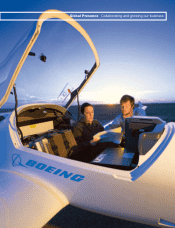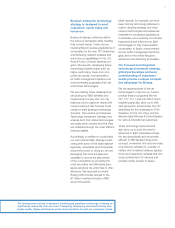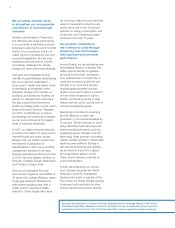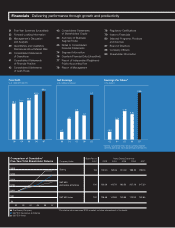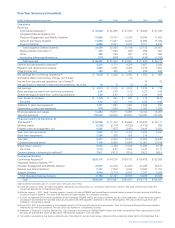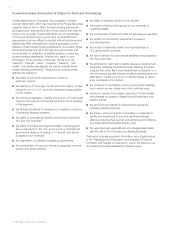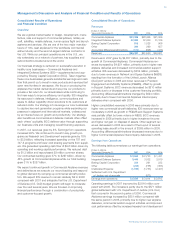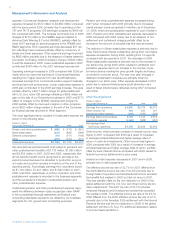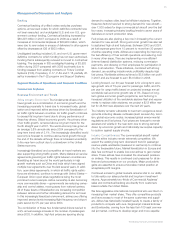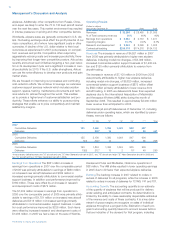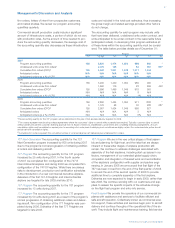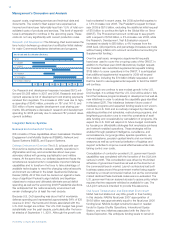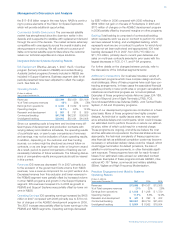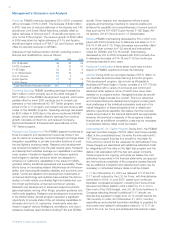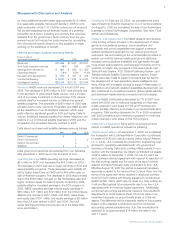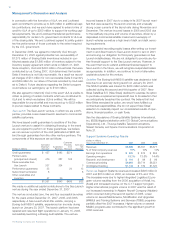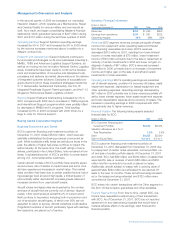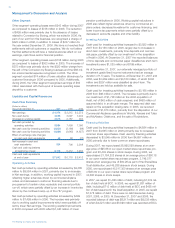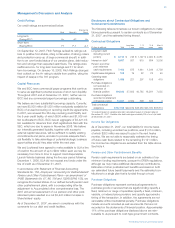Boeing 2007 Annual Report Download - page 28
Download and view the complete annual report
Please find page 28 of the 2007 Boeing annual report below. You can navigate through the pages in the report by either clicking on the pages listed below, or by using the keyword search tool below to find specific information within the annual report.25
Management’s Discussion and Analysis
Backlog
Contractual backlog of unfilled orders excludes purchase
options, announced orders for which definitive contracts have
not been executed, and unobligated U.S. and non-U.S. gov-
ernment contract funding. Contractual backlog increased by
$80,397 million in 2007 compared to 2006 as a result of
increases at Commercial Airplanes of $80,900 million, which
were due to new orders in excess of deliveries for all programs
offset by decreases at IDS of $503 million.
Unobligated backlog includes U.S. and non-U.S. government
definitive contracts for which funding has not been authorized.
Funding that is subsequently received is moved to contractual
backlog. The decrease in IDS unobligated backlog of $3,502
million during 2007 compared with 2006 is primarily due to
funding released from existing contracts on Future Combat
Systems (FCS), Proprietary, C-17, P-8A and F-18, partially off-
set by increases in the F-22 program and Support Systems.
Segment Results of Operations and Financial Condition
Commercial Airplanes
Business Environment and Trends
Airline Industry Environment The fundamental drivers of air
travel growth are a combination of economic growth and the
increasing propensity to travel due to increased trade, global-
ization and improved airline services driven by liberalization of
air traffic rights between countries. Air traffic growth continues
to exceed its long-term trend due to strong performance of
these key drivers. Global economic growth, the primary driver
of air traffic growth, remained above long-term trend for the
fourth straight year in 2007. The world economy has grown at
an average 3.8% annual rate since 2004 compared to the
long-term trend rate of 3.1%. The increasingly diversified world
economy is forecast to continue above-trend growth through
the end of the decade although there is increased uncertainty
in the near-term outlook due to a slowdown in the United
States economy.
Increasingly liberalized and competitive air travel markets are
also supporting strong traffic growth. Many bilateral air service
agreements governing air traffic rights between countries are
liberalizing air travel around the world particularly in high
growth markets such as China and India which have signed
multiple new agreements over the last several years. In addi-
tion, open skies agreements, in which all traffic rights restric-
tions are eliminated, continue to emerge with United States—
European Union open skies negotiations being the most
prominent recent example. Airline ownership is also becoming
more commercially driven— governments are reducing owner-
ship and control stakes, moving away from national carriers.
All of these facets of liberalization are increasing competition
between airlines and further stimulating demand for air travel.
In this increasingly liberalized environment, airlines are offering
improved service levels increasing flight frequency and airport
pairs served by 5% per year since 2004.
The combination of these two fundamental drivers has led to
a 9% annual average increase in the number of passengers
since 2003. In addition, high fuel prices are spurring strong
demand to replace older, less fuel efficient airplanes. Together,
these two factors have led to strong demand for new aircraft—
over 7,000 orders for large commercial jet aircraft over the last
four years, increasing industry backlog levels to seven years of
deliveries at current production rates.
Fuel prices are also playing a key role in increasing the current
demand for new aircraft. Strong economic growth has also led
to sustained high oil and fuel prices. Between 2003 and 2007,
jet fuel expense grew from 15 percent to more than 30 percent
of airline operating costs. Airlines are responding by improving
the fuel efficiency of their aircraft operations and reducing cost
in many other areas. They are implementing more efficient
(internet based) distribution systems, reducing commission
payments, and drawing on their employees for participation in
labor cost reduction. These initiatives, combined with strong
demand, are enabling industry-wide profitability despite high
fuel prices. Worldwide airlines achieved a $5.6 billion net profit
in 2007 and are forecast to earn $5.0 billion in 2008.
Looking forward, our 20-year forecast is for a long-term aver-
age growth rate of 5% per year for passenger traffic, and 6%
per year for cargo traffic based on projected average annual
worldwide real economic growth rate of 3%. Based on long-
term global economic growth projections, and factoring in
increased utilization of the worldwide airplane fleet and require-
ments to replace older airplanes, we project a $2.8 trillion mar-
ket for 28,600 new airplanes over the next 20 years.
The industry remains vulnerable to near-term exogenous devel-
opments including disease outbreaks (such as avian flu), terror-
ism, global economic cycles, increased global environmental
regulations and fuel prices. Fuel prices are forecast to remain
elevated and volatile in the near-term due to strong demand
driven by economic growth and historically low surplus capacity
to cushion against supply shocks.
Industry Competitiveness The commercial jet aircraft market
and the airline industry remain extremely competitive. We
expect the existing long-term downward trend in passenger
revenue yields worldwide (measured in real terms) to continue
into the foreseeable future. Market liberalization in Europe and
Asia has continued to enable low-cost airlines to gain market
share. These airlines have increased the downward pressure
on airfares. This results in continued cost pressures for all air-
lines and price pressure on our products. Major productivity
gains are essential to ensure a favorable market position at
acceptable profit margins.
Continued access to global markets remains vital to our ability
to fully realize our sales potential and long-term investment
returns. Approximately two-thirds of Commercial Airplanes’
sales and contractual backlog are directly from customers
based outside the United States.
We face aggressive international competitors who are intent on
increasing their market share. They offer competitive products
and have access to most of the same customers and suppli-
ers. Airbus has historically invested heavily to create a family of
products to compete with ours. Regional jet makers Embraer
and Bombardier, coming from the less than 100-seat commer-
cial jet market, continue to develop larger and more capable
The Boeing Company and Subsidiaries


